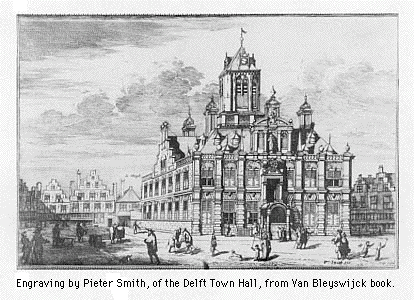

Go to Text in Dutch / Nederlands.
The Delft city hall is a remarkable and festive building, both inside and out. Of the original mediaeval building of the Stadhuis or Raadhuis, located on Markt square, which burnt down in 1618, only the squat central tower towards the back now remains. The rest of the edifice was rebuilt around it in 1620 in a festive Northern Renaissance style by architect Hendrick de Keijser (1565-1621).
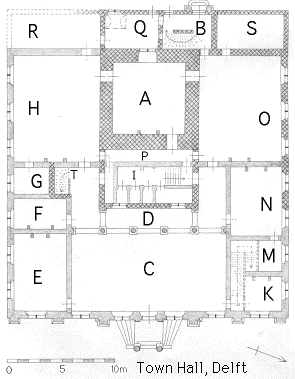 Thanks
to the Description of Delft, written by Van
Bleyswijck and published in 1667 we are able to take a ful tour
of the city hall in that year. The following text has been based both
upon Van Bleyswijck and on the modern architectural researcher A de
Groot. he published his excellent article 'Het Stadhuis' in the
exhibition catalogue De Stad Delft, cultuur en maatschappij van
1572 tot 1667. p. 49 to 51. His floor plan is also reproduced
here, with enlarged letter indications for legibility.
Thanks
to the Description of Delft, written by Van
Bleyswijck and published in 1667 we are able to take a ful tour
of the city hall in that year. The following text has been based both
upon Van Bleyswijck and on the modern architectural researcher A de
Groot. he published his excellent article 'Het Stadhuis' in the
exhibition catalogue De Stad Delft, cultuur en maatschappij van
1572 tot 1667. p. 49 to 51. His floor plan is also reproduced
here, with enlarged letter indications for legibility.
Entrance hall of Citizens Hall (C)
This Hall was a fine place for strolling and waiting for those citizens who had business with the mayors or aldermen. During fairs or cheese markets a number of merchants were allowed to trade there in books, maps, paintings, prints or paper cuttings ("Boecken/ Kaerten/ Schilderyen/Prenten en Papier-kunst").
The all-pervasive power of the town to govern and to punish was shown by the wooden cloak ("houte huyck"), an extraordinary torture instrument which was hung from one of the beams in the middle of this hall.
Just like other major city halls in the Netherlands this great hall also boasted a "vierschaar" or 'four judges seat'. It was positioned centrally behind an arcade and was properly furnished with tables and benches. Every Wednesday and Saturday, except for during vacation days, a roll call was held, decrees were read and published, rents for lands and town properties were made known and finally sentences for criminals were read. Behind the Vierschaar one could see the painting "Judgement of Salomo", by Pieter van Bronckhorst.
Orphans Chamber (E)
The orphans chamber with its red sandstone floor was furnished in a sober manner. To the right was a cupboard. Towards the west, above the chimney, was a very ancient and venerable Ecce Homo, which was "painted in a wondrous way, just as if it had been finished yesterday". The room also showed a portrait of Johannes Koelman, rector of the St. Agatha convent, painted by Maerten van Heemskerck, and a painting of the terrifying ice mountain which on January 2, 1565 had threatened the town of Delfshaven, this harbour town being under the jurisdicition of Delft. There were some other minor paintings.
Secret Document Storage Room (G)
Next to the messenger room (Bodenkamer, F) was the secret document storage room, in which the mayors kept their most confidential papers. This room could be reached via the Mayors room. It should be noted that in the Republic, towns had major powers to govern, making them almost city-states.
 Mayor's
room - Burgermeesterenkamer (H)
Mayor's
room - Burgermeesterenkamer (H)
In this Burgermeesterenkamer was partitioned with a low fence, and the mayors were seated in the section behind this fence. Audience was thus given behind bars to citizens, visitors or foreign guests. In the back was another section for the mayors, with a table and a set of chairs. These were all on a low wooden platform.
The interior decoration was composed with great care in order to create a lofty atmosphere which accentuated the social distance between the common folks and the burgomasters.
On politics: The central core of power was the called 'Council of forty' or "Veertigraad". The members of this Council were chosen by co-option from candidates within the group of foremost Protestant families in town. The four elected burgomasters presided over this lofty group of forty and took care of day to day governing of Delft. The mayors were assisted by a paid secretary called "Pensionaris" and by a staff of Aldermen ("schepenen") and other town officials taking care of all local governing matters.
There was no police force as we now know it. Matters were taken by citizens to a Notary Public for a sworn statement to be drawn up, and if a given problem in society persisted, the matters would be brought to the attention of the Aldermen. The chance for a criminal to be caught was slim, but once caught the pubishment was severe.
In order to reach a maximum effect of visual opulence and distance the council had ordered a set of at least four locally made wall tapestries. Simon de Vlieger was probably the artist who provided the design cartons for the weavers. Production took place in 1640-1641 in the Delft workshop of Maximiliaen van der Gucht. The finished tapestries were hung on the walls from a high lattice, and reached all the way down to the floor.
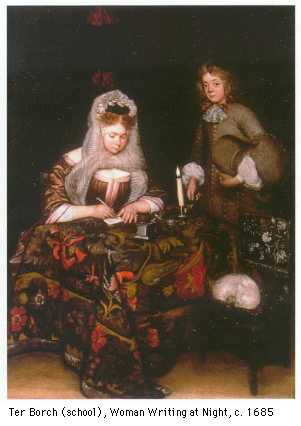 Furthermore
there was a rich set of tapestry covered pillows which came from the
same Van der Gucht workshop. Author
Van Bleijswijck describes the stunning effect:
Furthermore
there was a rich set of tapestry covered pillows which came from the
same Van der Gucht workshop. Author
Van Bleijswijck describes the stunning effect:
These wall tapestries showed mainly allegorical figures, arms and scroll work. Upon entering one saw the grand Delft Arms bordered by ornamental designs of trees, plants and kitchen vegetables. The arms were crowned by double wreaths. On one side emerged the spear of Minerva, Goddess of Wisdom with her bird the night-owl indicating the gift of discernment. (...). At the other side one sees the Caduceum or Snake-staff of Mercury, God of eloquence (...) to which is added the cock of alertness (...). Furthermore the Delft Arms is positioned between two Water Gods, possibly depicting the River Rhine and River Maas / Meuse. (...) or alternatively River Maas and River Schie (...) One also sees in perspective some ships and vessels on sea and rivers. The one Water God has an overflowing water barrel on which he leans (...), the other is in the shape of a Lady, leaning just like the former. Between the two of them, under the Delft Arms lies a beer barrel showing the source of wealth for inhabitants of this town. On the foreground next to her is a wealth of green river and ditch of greenery (...) From the back one sees the hanging festoons of sea-horns and shells.Other tapestries in this room had other designs: The Arms of various land authorities under the jurisdiction of this town, adorned with scrollwork and festoons af manifold plants from fields, trees and tools used in agriculture, hunting, and fishing, with their results in fowl and fish.
Next to the chimney hung a trophee formed by four coloured flags of the four city quarters of the Civic Guards, with a wealth of ancient guns once used here, as well as hooks, shotguns ("clovenieren"), foot bows and hand bows.
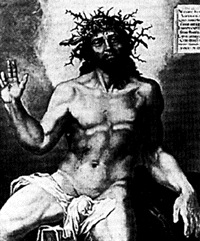 Above
this set of tapestries, which were hung from a lattice, were a set of
fourteen paintings. Five of these were safeguarded from Delft Roman
catholic churches of before the iconoclasm rages and the religous
alteration of 1572. Apart from a long and high side panel by
Pieter Aertsen, depicting the "Presentation in the Temple", were four
important works by Maerten van Heemskerck: Above the chimney a
tryptich with "Ecce Homo" in the middle and the patrons and saints on
either sides, among them "St. Christopher". Next to it another
"Ecce Homo", again lifesize, but without people.
Above
this set of tapestries, which were hung from a lattice, were a set of
fourteen paintings. Five of these were safeguarded from Delft Roman
catholic churches of before the iconoclasm rages and the religous
alteration of 1572. Apart from a long and high side panel by
Pieter Aertsen, depicting the "Presentation in the Temple", were four
important works by Maerten van Heemskerck: Above the chimney a
tryptich with "Ecce Homo" in the middle and the patrons and saints on
either sides, among them "St. Christopher". Next to it another
"Ecce Homo", again lifesize, but without people.
The painting shown here is not necessarily the one from the Delft city hall. Emperor Rudolf II offered the grand sum of 4000 guilders to the Town of Delft, which refused to sell it. However as Van Heemskerck's style later on fell out of favour, a group of Van Heemskerck paintings was sold off 1860.
At the other side of the chimney a wing from an altar with on one side the kneeling donor with St. Paul, and on the reverse the Sybilla Erythrea [now in Rijksmuseum, Amsterdam]; this painting was turned over every year as it is equally beautiful on either side. The fourth Van Heemskerck painting was on the other wall and showed the, "Lamentation of Christ", 1566, now in Prinsenhof museum.
Another Van Heemskerk, 'The crowning with Thorns' dating from 1545-1550, is now in the Frans Halsmuseum, Haarlem.
Nine other paintings were by Michiel van Mierevelt, all commissioned by the Town, and showing portraits of members of the reigning house of Orange-Nassau.
After 1667 another item was added, the grand Figurative Map of Delft, presented in an opulent frame. This map is one of the finest birds eye views ever made of any town.
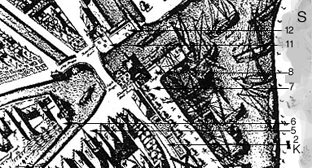
The glass panels of the three cross beam windows in the south facade showed a set of six arms of the major Netherlandish towns. These were, in the traditional order, Dordrecht, Haarlem, Delft, Leiden, Amsterdam and Gouda.
The small room in the annex behind the Mayors room was covered in gold tooled leather wall hangings.
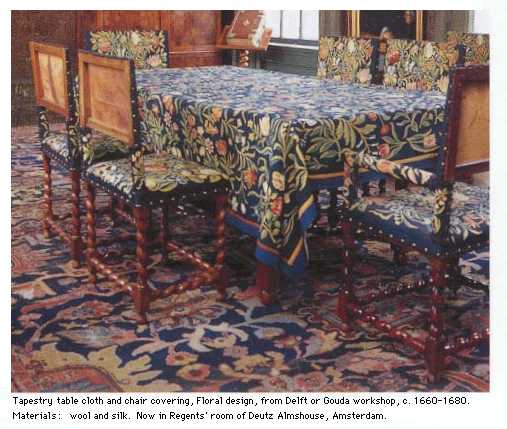

The Council Chamber (A)
Council Camber was a secret meeting room within the fortress-like walls of the ancient tower of the old city hall. This room could be reached by three sets of double doors, which could be locked. In it the Council of forty convened. For a chart of politics see above under the Mayor's room - Burgermeesterenkamer.
The council of forty met in full strength only in order to discuss both town and national affairs of the highest importance.
The walls in this room were covered with tapestries as well. These were produced in 1662-1663 in the workshop of Maximiliaen van der Gucht. The scenes showed fine landscapes. The council of forty sat on forty chairs, all covered in spanish leather, plus one presidential arm chair. The design of the cushion fabric of these chairs was of great opulence: tapestry in a pattern of scattered flowers, from the same workshop.
Out of the forty about a third were active in town governing. When convening, these Lords of the Law ("Heeren van de Weth") used about a third of these chairs. The others were positioned in a row alongside the tapestries. The Town Secretary or "Pensionaris" could sit or stand behind a lectern when he spoke on behalf of the mayors and aldemen, and when he collected votes and makes reports from the meetings of the States of Holland.
Aldermans's room - schepenkamer (O)
The walls of the aldeman's room was covered with paintings and maps. One of these showed the assassinated Prince William of Orange the Elder in the company of great numbers of Virgins, signifying many Christian, political and military virtues; this painting was done by H.G. Pot and was dated 1620. Above the chimney was another "Ecce Homo" by Maerten van Heemskerck and opposite from the windows was a "Moses and the Copper snake", a large altar piece in grisaille, again by Van Heemskerck. Next to the chimney hung a panel of the 'Tower of the New Church before the fire of 1536', and above the portal in the back was a "Battle of Constantin the Great".
The collection of various maps were assembled in 1678 and they were all presented in richly carved frames with symbolic images and text. The windows contained images of the Delft Arms.
 Secretariat
(N)
Secretariat
(N)
The secretariat which contained the work space for clerks, was soberly furnished. All manners of papers concerning ordinances, placards, decisions, letters and registers were handled here. The wall bookcases were filled with a multitude of books, papers and certificates.
The inner secretariat (M)
The inner secretariat contained the most important archives and secret papers, stored under fireproof stone vaults and locked behind an iron door. The heads of the secretariat had their seats in there.
Treasury (K)
The treasury was a minor square room in which income and expenses were registered. One may imagine a counter-like teller window by the entrance. The papers of the treasury were stored upstairs in the Treasury archives.
Civic Guard Room (upstairs above rooms B and Q)
On the upper floor was the civic guard room in which one platoon of guards was on duty call every night. They could rush out via their private stone stairwell in the middle of the room, an opening which was secured on three sides by an iron fence. In wintertime these men could warm up against the chimney on the shorter western wall. This chimney was wide and could burn major fires in winter, and for safety the floor underneath was bricked up. A long table was placed between the fenced stairwell and the chimney. There were a number of peat chests (peat was used as an excellent fuel), and above these chests were racks with pins for hanging musquets and half-pikes.
Gold and Silver testing room
Upstairs, next to the civic guard room was the room where gold and silver objects were tested and stamped for approval. In this room the municipal foreign currency exchange bank was operated as well.
On market square there was an annual eight-day market in June, called St Odulphus. Linen, furs, shoes, hardware was for sale and of course lots of pitchers of beer.
At the back, by the fortification tower, to the right hand side of the main door, was a cage which held two eagles. These were the city eagles and for centuries there was even a special caretaker to feed them. When one eagle died another one was purchased at great cost to the city (more that 40 guilders). This tradition was discontinued in 1755 in order to save cost.
Literature:
A. de Groot, 'Het Stadhuis' in: De Stad Delft, cultuur en maatschappij van 1572-1667, Vol I, page 40-51 in the exhibition catalogue Museum Prinsenhof Delft, 1981. A. de Groot also wrote the provisional research report entitled "Overzicht van de bouwkundige geschiedenis van het stadhuis te Delft", (February 1980), which was made in order to prepare for the internal restoration of the building.
E. Neurdenburg, Hendrick de Keyser, beeldhouwer en bouwmeester van Amsterdam, Amsterdam no year (1929).
Hendrick de Keijser, Architectura Moderna ofte bouwinge van onsen tyt, Amsterdam 1631.
D. van Bleyswijck, Beschrijvinge der Stadt Delft, Delft 1667/1678.
This page forms part of a large encyclopedic site on Delft. Research by Drs. Kees Kaldenbach (email). A full presentation is on view at johannesvermeer.info.
Launched 16 February 2001; Last update March 1, 2017.